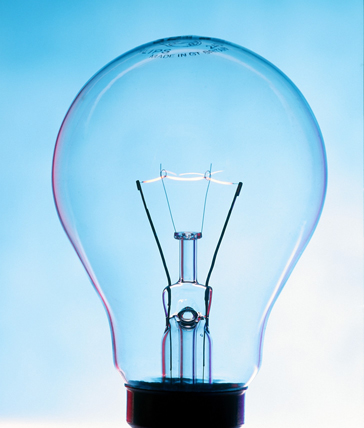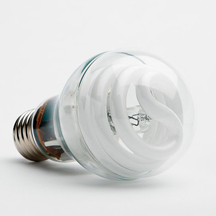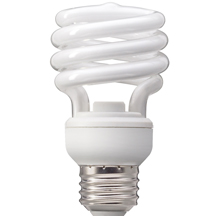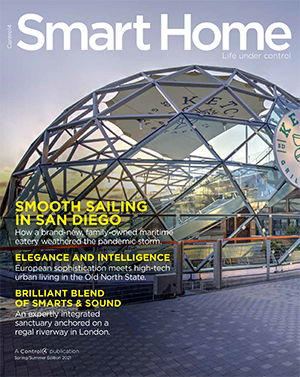The End of the Incandescent Bulb Brings a New Era of Lighting
December 17, 2013
This post comes to us from Scott Stephenson, Sr. Product Manager, Lighting & Comfort.

As “the lighting guy” at Control4, I get a lot of questions along the lines of:
· Have incandescent light bulbs been outlawed?
· What kind of light bulbs should I be using? And…
· What can I expect from these newfangled CFL and LED lights?
Not surprisingly, the answers to these questions are not always simple or straighforward.
Things used to be pretty simple. The traditional incandescent light bulb served us very well ever since its invention in the late 1800s. Incandescent bulbs provide excellent quality light, are cheap to manufacture, and are easily dimmable – from 1% to 100% — a wonderful effect that we’ve all grown to know and love. As an incandescent bulb dims, the light gets “warmer,” giving it that pleasant fire-like glow that’s so important to achieving the right mood in a dining room or bedroom.
The only real downside to incandescents is that they are very inefficient at converting electricity to light. A typical incandescent bulb converts 90% of the electricity used into heat – only 10% becomes light. This inefficiency is what is pushing many states and countries to pass laws that either encourage the use of higher efficiency light bulbs or ban the use of lower efficiency light bulbs. In many countries that Control4 serves, it’s becoming extremely rare to find an incandescent light bulb anywhere. In the U.S., the Energy Independence and Security Act of 2007 set efficiency standards for household and commercial lighting. While this law does not technically ban incandescent light bulbs, it does set specific efficiency requirements that a traditional incandescent light bulb is not able to achieve.
It’s important to note that the law is fairly specific, though, as to what types of light bulbs must achieve these new efficiency requirements and there are a whole lot of exemptions. The law really only applies to 40W to 100W “Edison style” bulbs – i.e. the traditional teardrop shaped light bulbs that are mostly used in lamps and ceiling fixtures. Light bulbs below 40W and above 100W are exempt from the law as are “3-way” bulbs, candelabra style bulbs below 60W, rough-service bulbs, appliance lamps, and reflector floods.
So, while it’s technically not true that “all incandescent lights have been banned,” they are definitely becoming a lot harder to find in certain styles as these laws go into effect and as we as consumers demand more energy efficient lighting. What, then, are your options today and into the future?
Stock up on incandescents
OK, I’ll admit it – I’ve done this a bit. 100W and 75W incandescents are almost impossible to find at this point but if you really like the light quality and dimmability of incandescents, you might want to load up on 60W and 40W bulbs before they become subject to the energy efficiency requirements at the end of 2013.

Energy Efficient Halogens
While not as energy efficient as CFLs or LEDs, many halogen bulbs are able to achieve the required energy efficiency to meet the requirements of the U.S. law (although this might change in 2020). Halogen bulbs produce the same great quality light and have the same excellent dimmability as incandescents. They’re also relatively inexpensive and typically last about twice as long as incandescents. Halogens are most commonly used in bulbs for recessed can fixtures but are starting to become available even in traditional Edison-style bulbs. The latter can be a great option for floor and table lamps when you want full dimmability (using a Control4 Outlet Dimmer for example). They are also great for enclosed ceiling fixtures since CFLs and LEDs typically aren’t supposed to be installed in enclosed fixtures.

Compact Fluorescents (CFLs)
CFLs have been commercially available since the late 1980s and typically use about one-fifth the amount of energy as an equivalent incandescent bulb. They also can last about 10 times as long as an incandescent. However, frequent on/off cycling can significantly reduce that lifespan. As such, CFLs are best used in locations where the lights will be turned on and left on for a while. While CFLs have certainly improved over the last few years, they still have a number of downsides. First and foremost, the quality of light just isn’t that great. They can take a while to warm up to full brightness, they’re prone to flicker, and the color of the light produced can be a bit odd. They also don’t dim very well – even with the ones labeled dimmable. At best, you’re likely only going to be able to dim them down to about 20%-25%. Because of the way the human eye dilates in lower light, a 25% measured brightness is actually 50% perceived brightness. Finally, all CFLs contain a small amount of mercury. As such, they need to be properly recycled. You can’t just toss them in the trash.

LEDs
LEDs (Light Emitting Diodes) are definitely the way of the future. Almost all of the major research and development effort occurring in the lighting world is happening in the LED arena. This is resulting in continuously improved performance and reduced cost. LED lamps can be ten times as efficient as an incandescent (or more) and can last as much as 50 times as long. Since LED technology is evolving so rapidly, you’ll still find wide variability in the performance of LED lights – especially when it comes to how well they dim. We’ve tested LEDs in our lab that provide the same dimming range as incandescents and other LEDs that only dim down to about 60% (or worse). Since LEDs are really just electronics, there are an incredible number of international (or unregulated) manufacturers jumping into the market with inferior products. While prices are coming down, we are still in the stage of “you get what you pay for.” You’ll also find that fixtures designed specifically for LEDs can provide much better performance than replacement bulbs.
Admittedly, this can all be a bit overwhelming. Your Control4 dealer can help you navigate this maze but, if you’re getting ready to build a new home or embarking on a major remodel, I highly recommend using a lighting design professional. Not only will they be able to help you choose the right technology for each situation, they can create layers of light that highlight the beauty of your home.
As “the lighting guy” at Control4, I get a lot of questions along the lines of:
· Have incandescent light bulbs been outlawed?
· What kind of light bulbs should I be using? And…
· What can I expect from these newfangled CFL and LED lights?
Not surprisingly, the answers to these questions are not always simple or straighforward.
Things used to be pretty simple. The traditional incandescent light bulb served us very well ever since its invention in the late 1800s. Incandescent bulbs provide excellent quality light, are cheap to manufacture, and are easily dimmable – from 1% to 100% — a wonderful effect that we’ve all grown to know and love. As an incandescent bulb dims, the light gets “warmer,” giving it that pleasant fire-like glow that’s so important to achieving the right mood in a dining room or bedroom.
The only real downside to incandescents is that they are very inefficient at converting electricity to light. A typical incandescent bulb converts 90% of the electricity used into heat – only 10% becomes light. This inefficiency is what is pushing many states and countries to pass laws that either encourage the use of higher efficiency light bulbs or ban the use of lower efficiency light bulbs. In many countries that Control4 serves, it’s becoming extremely rare to find an incandescent light bulb anywhere. In the U.S., the Energy Independence and Security Act of 2007 set efficiency standards for household and commercial lighting. While this law does not technically ban incandescent light bulbs, it does set specific efficiency requirements that a traditional incandescent light bulb is not able to achieve.
It’s important to note that the law is fairly specific, though, as to what types of light bulbs must achieve these new efficiency requirements and there are a whole lot of exemptions. The law really only applies to 40W to 100W “Edison style” bulbs – i.e. the traditional teardrop shaped light bulbs that are mostly used in lamps and ceiling fixtures. Light bulbs below 40W and above 100W are exempt from the law as are “3-way” bulbs, candelabra style bulbs below 60W, rough-service bulbs, appliance lamps, and reflector floods.
So, while it’s technically not true that “all incandescent lights have been banned,” they are definitely becoming a lot harder to find in certain styles as these laws go into effect and as we as consumers demand more energy efficient lighting. What, then, are your options today and into the future?
Stock up on incandescents
OK, I’ll admit it – I’ve done this a bit. 100W and 75W incandescents are almost impossible to find at this point but if you really like the light quality and dimmability of incandescents, you might want to load up on 60W and 40W bulbs before they become subject to the energy efficiency requirements at the end of 2013.
Energy Efficient Halogens
While not as energy efficient as CFLs or LEDs, many halogen bulbs are able to achieve the required energy efficiency to meet the requirements of the U.S. law (although this might change in 2020). Halogen bulbs produce the same great quality light and have the same excellent dimmability as incandescents. They’re also relatively inexpensive and typically last about twice as long as incandescents. Halogens are most commonly used in bulbs for recessed can fixtures but are starting to become available even in traditional Edison-style bulbs. The latter can be a great option for floor and table lamps when you want full dimmability (using a Control4 Outlet Dimmer for example). They are also great for enclosed ceiling fixtures since CFLs and LEDs typically aren’t supposed to be installed in enclosed fixtures.
Compact Fluorescents (CFLs)
CFLs have been commercially available since the late 1980s and typically use about one-fifth the amount of energy as an equivalent incandescent bulb. They also can last about 10 times as long as an incandescent. However, frequent on/off cycling can significantly reduce that lifespan. As such, CFLs are best used in locations where the lights will be turned on and left on for a while. While CFLs have certainly improved over the last few years, they still have a number of downsides. First and foremost, the quality of light just isn’t that great. They can take a while to warm up to full brightness, they’re prone to flicker, and the color of the light produced can be a bit odd. They also don’t dim very well – even with the ones labeled dimmable. At best, you’re likely only going to be able to dim them down to about 20%-25%. Because of the way the human eye dilates in lower light, a 25% measured brightness is actually 50% perceived brightness. Finally, all CFLs contain a small amount of mercury. As such, they need to be properly recycled. You can’t just toss them in the trash.
LEDs
LEDs (Light Emitting Diodes) are definitely the way of the future. Almost all of the major research and development effort occurring in the lighting world is happening in the LED arena. This is resulting in continuously improved performance and reduced cost. LED lamps can be ten times as efficient as an incandescent (or more) and can last as much as 50 times as long. Since LED technology is evolving so rapidly, you’ll still find wide variability in the performance of LED lights – especially when it comes to how well they dim. We’ve tested LEDs in our lab that provide the same dimming range as incandescents and other LEDs that only dim down to about 60% (or worse). Since LEDs are really just electronics, there are an incredible number of international (or unregulated) manufacturers jumping into the market with inferior products. While prices are coming down, we are still in the stage of “you get what you pay for.” You’ll also find that fixtures designed specifically for LEDs can provide much better performance than replacement bulbs.
Admittedly, this can all be a bit overwhelming. Your Control4 dealer can help you navigate this maze but, if you’re getting ready to build a new home or embarking on a major remodel, I highly recommend using a lighting design professional. Not only will they be able to help you choose the right technology for each situation, they can create layers of light that highlight the beauty of your home.
